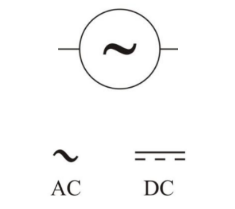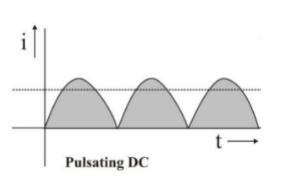Due to the growing popularity of electricity, two of the greatest inventors of all time, Thomas Edison and Nikola Tesla, worked on transferring electricity around a century and a half ago. They devised a scheme to transport electricity from power plants to every home, which they believed was the way of the future.
Edison believed that direct current was the most cost-effective, safe, and efficient way to transmit energy over long distances, while Tesla believed in alternating current. The sources of alternating and direct current differ, and they are measured using separate ammeters and voltmeters. We’ll look at the definitions of AC and DC, as well as the sources of AC and DC and the benefits of AC over DC, in this article.
Electric Current
A stream of charged particles, such as electrons or ions, travelling through an electrical conductor or space is referred to as an electric current. It is the time-dependent flow rate of electric charge across a conducting medium. The symbol “I” or i is used to represent electric current in mathematics (for example, in formulas). Ampere or amp is the unit for current. A is the symbol for this.
Mathematically, the rate of flow of charge with respect to time is known as Current.
I=dQ/dt
In other words, an electric current is a stream of charged particles passing through an electrical conductor or space. Charge carriers are the moving charged particles, which might be electrons, holes, ions, and so on.
An electric current flows from a higher potential to a lower potential when an electrical potential difference is applied between two sites in a conductive medium. The greater the voltage or potential difference between two places, the more current flows between them.
Current cannot flow if two points in a circuit have the same potential. A current’s magnitude is determined by the voltage or potential difference between two locations. As a result, we can state that current is the effect of voltage.
Electromagnetic fields are produced by electric current and are used in inductors, transformers, generators, and motors. Current induces resistive heating or joule heating in electric conductors, which produces light in an incandescent lamp.
Electromagnetic waves are produced by a time-varying electric current and are utilized in telecommunications to broadcast data.
Types of Electric Current
The movement of electric charge via a conductor is known as an electric current. Electric current is divided into two forms based on the flow of electrons that make up the current: direct current and alternating current.
Direct Current (DC)
Direct current, often known as DC, is an electric current in which electrons flow in the same direction all of the time. The symbols for a DC source and a DC voltmeter are as follows:

Unidirectional current is produced by DC generators, fuel cells, solar cells, and electric cells. Because the positive and negative terminals of DC sources are fixed, they have a constant polarity. The graphical representation of a steady direct current is shown below. Even if the amount of the current changes, it is still a direct current if it only goes in one direction.
Types of DC
Pulsating DC
Constant DC
For various devices, direct current can be obtained from DC sources with a wide range of voltages such as 1.5 V, 4.5 V, 6 V, 9 V, 12 V, and so on. The majority of DC circuits have a low voltage. The battery in your automobile is around 12 V, which is about as high a DC voltage as most people ever use.
An inverter, which is utilized as a power backup device in domestic works and it may convert DC to AC using an Inverter.
Application of Direct Current
Portable electronics such as a flashlight, pocket calculator, or CD player use direct current. Computers, television sets, and electroplating processes all use direct current.
Alternating Current (AC)
An alternating current (AC) is an electric current in which the flow of electrons reverses direction at regular intervals of time. They never get around the circuit, switching back and forth between relatively fixed places. An AC source’s circuit sign is as follows:

The standard voltages for AC are 220V and 110V, which are used all around the world.
An alternating current is produced by an AC generator, which was invented by Nikola Tesla.
An alternating current as a function of time is depicted graphically below. When electrons flow in one direction, the current is positive; when they flow in the opposite direction, the current is negative.

The voltage of simple direct current circuits is usually all that is needed to characterize them. However, alternating current circuits require an additional characteristic, frequency, to be described. It is 50Hz, or 50 cycles per second, in most parts of the world. This means that the electrons travel 50 times per second ahead and backward. The frequency in most parts of the United States and Canada is 60Hz.
Throughout the world, the current flowing in power cables that reach wall outlets in homes, schools, and industries alternates.
Both alternating and direct currents can be used to power electrical equipment such as light bulbs and heaters that convert electricity directly into other kinds of energy, such as heat. Almost all modern electronic equipment, such as laptops and mobile phones, however, require direct current to operate. These devices’ converters are intended to convert AC from a household socket to DC.
A rectifier diode can be used to convert AC to DC.
Advantages of AC over DC
There are following advantages of AC over Dc which are Mentioned below:
- AC generation is more cost-effective than DC generation.
- A transformer may quickly raise or reduce the alternating voltages and hence the current.
- Alternating voltages can be affordably transported to remote locations with very little loss of electric power. AC power generated at a remote location is boosted to a very high voltage for long-distance transmission using a step-up transformer. It is then gradually decreased to a safe, low voltage for distribution to individual households and companies, using step-down transformers.
Conclusion
A stream of charged particles, such as electrons or ions, travelling through an electrical conductor or space is referred to as an electric current. It is the time-dependent flow rate of electric charge across a conducting medium.
Direct current, often known as DC, is an electric current in which electrons flow in the same direction all of the time. An alternating current (AC) is an electric current in which the flow of electrons reverses direction at regular intervals of time. They never get around the circuit, switching back and forth between relatively fixed places.
AC generation is more cost-effective than DC generation.
A transformer may quickly raise or reduce the alternating voltages and hence the current.
 Profile
Profile Settings
Settings Refer your friends
Refer your friends Sign out
Sign out








